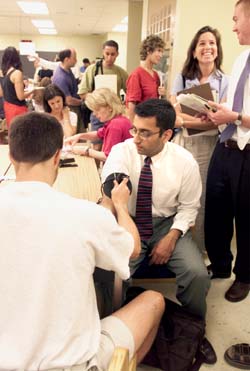
During the recent week-long orientation for incoming residents, Dr. Amit Chokshi received a personal wellness assessment from HealthPlus. (photo by Anne Rayner)
For new residents, school's over but learning continues
They come from diverse points across the nation and the globe, converging each summer on Vanderbilt University Medical Center.
They are, for the most part, newly minted physicians; recent graduates of medical school programs arriving here to begin their residency training. This year there are 156 new residents as well as 42 new fellows — a total of 198 new house staff members.
Recently, the new group got a head start on making the transition from medical student to house staff member through an intensive week-long orientation program sponsored by the Office of Graduate Medical Education.
They filled out the necessary paperwork for computer training assignments, health screenings, payroll and parking and attended numerous seminars on a wide variety of subjects relating to their new status as house officers. Presentations covered everything from OSHA training, Medicare compliance, malpractice and information management to a history of VUMC and its culture.
"The orientation is designed to provide the information that will help new residents adjust to their new responsibilities," said Dr. Fred Kirchner Jr., Associate Dean for Graduate Medical Education.
The total number of house staff at VUMC stands at about 680.
Their residencies range in length from three years — the minimum to qualify for a board examination — to eight years for certain specialties. Their basic responsibilities include everything from evaluating and managing patients to assisting and performing surgical procedures.
Kirchner's office serves as a central support center for residents, directing them to appropriate offices and people for information and support on a variety of issues, including dealing with the transition from student to resident.
The following is a breakdown of the number of incoming residents in each of 18 primary programs:
Anesthesiology — 10
Cardiothoracic Surgery — 1
Emergency Medicine — 8
General Surgery — 31
Surgical Critical Care — 1
Vascular Surgery — 1
Medicine — 39
Dermatology — 1
Medicine-Pediatrics — 5
Neurology — 2
Obstetrics and Gynecology — 6
Ophthalmology — 3
Pathology — 4
Pediatrics — 19
Plastic Surgery — 3
Psychiatry — 8
Radiology — 8
Urology — 1.













